外研版(2019) 必修第三册 Unit 1 Knowing Me, Knowing You Using Language课件(28张)
文档属性
| 名称 | 外研版(2019) 必修第三册 Unit 1 Knowing Me, Knowing You Using Language课件(28张) | 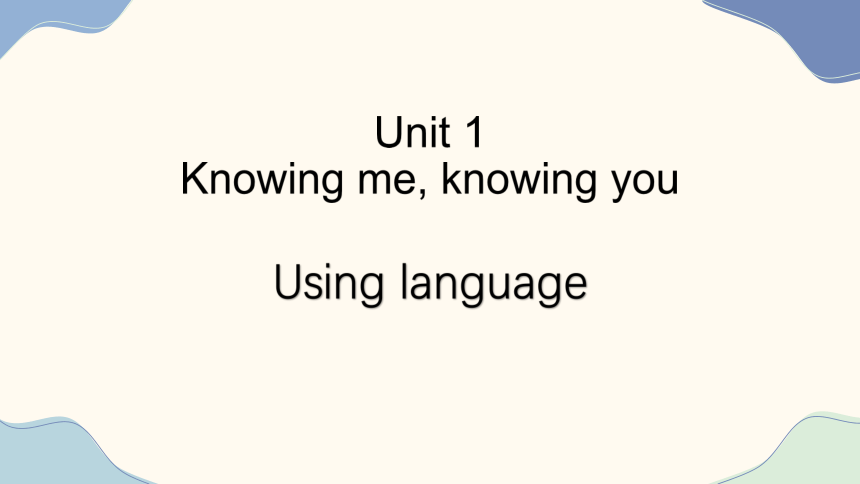 | |
| 格式 | zip | ||
| 文件大小 | 52.5MB | ||
| 资源类型 | 教案 | ||
| 版本资源 | 外研版(2019) | ||
| 科目 | 英语 | ||
| 更新时间 | 2022-06-01 07:39:05 | ||
图片预览

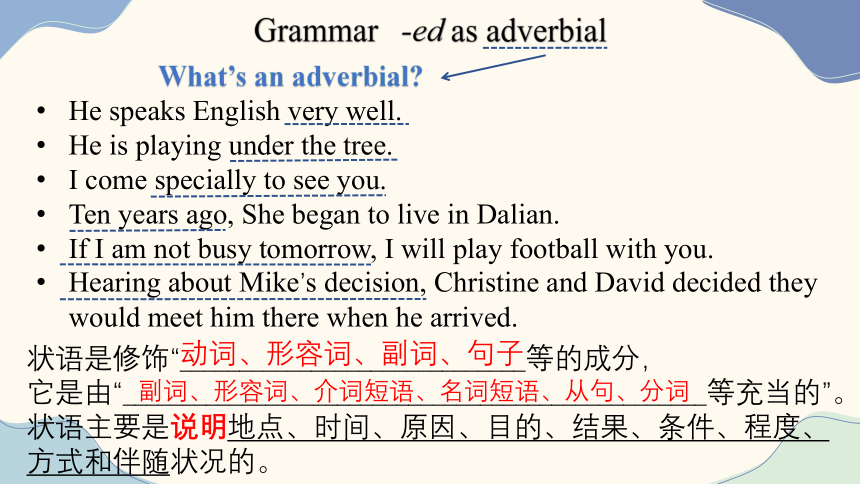

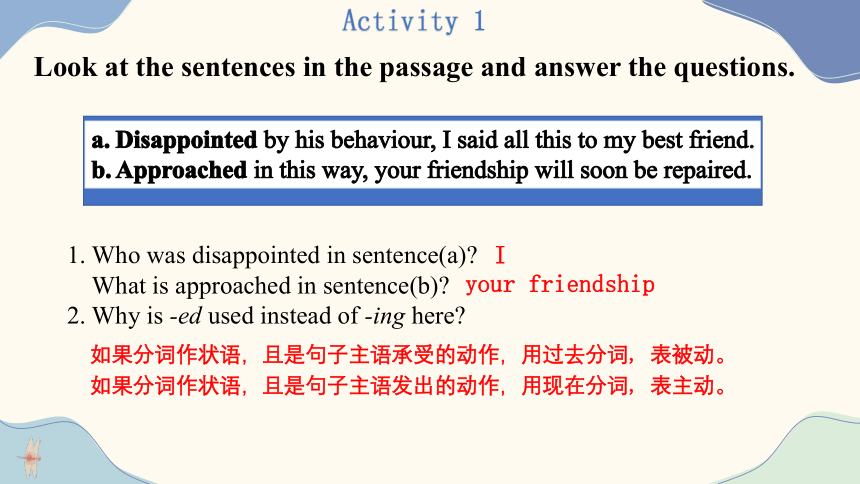

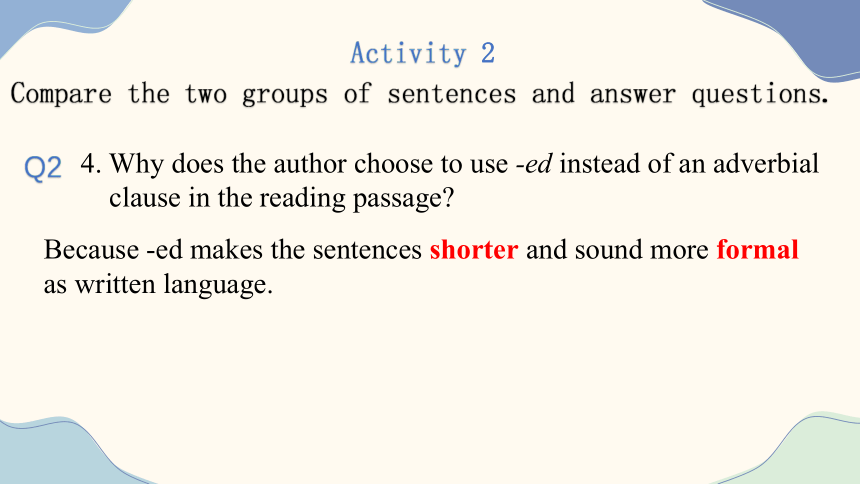
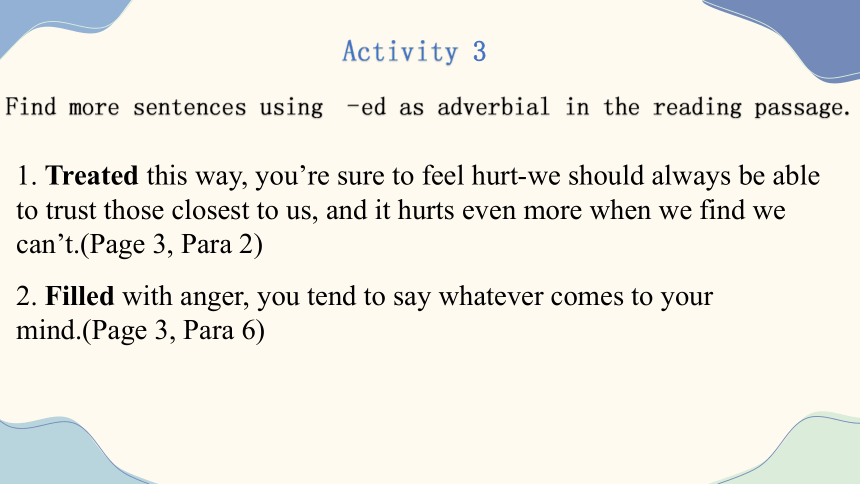
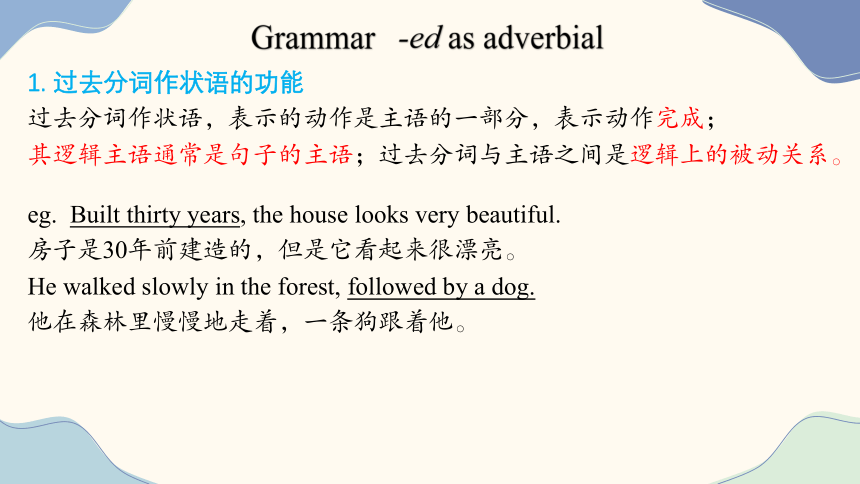
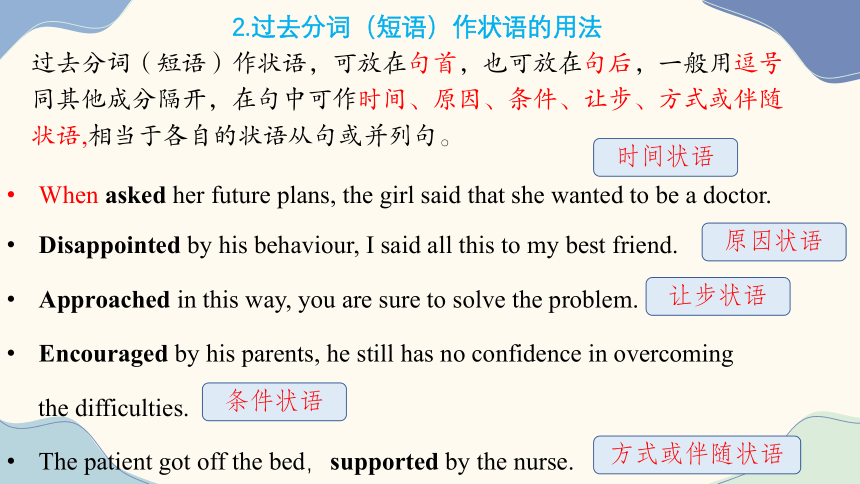
文档简介
(共28张PPT)
Unit 1
Knowing me, knowing you
Using language
Grammar -ed as adverbial
What’s an adverbial
He speaks English very well.
He is playing under the tree.
I come specially to see you.
Ten years ago, She began to live in Dalian.
If I am not busy tomorrow, I will play football with you.
Hearing about Mike’s decision, Christine and David decided they would meet him there when he arrived.
状语是修饰“_____________________________等的成分,
它是由“_________________________________________________等充当的”。
状语主要是说明地点、时间、原因、目的、结果、条件、程度、方式和伴随状况的。
动词、形容词、副词、句子
副词、形容词、介词短语、名词短语、从句、分词
Grammar -ed as adverbial
Look at the sentences in the passage and answer the questions.
Disappointed by his behaviour, I said all this to my best friend.
Approached in this way, your friendship will soon be repaired.
1. Who was disappointed in sentence(a)
What is approached in sentence(b)
2. Why is -ed used instead of -ing here
如果分词作状语,且是句子主语承受的动作,用过去分词, 表被动。
如果分词作状语,且是句子主语发出的动作,用现在分词, 表主动。
I
your friendship
Activity 1
Disappointed by his behaviour, I said all this to my best friend.
c. Because I was disappointed by his behaviour, I said all this to my best friend.
过去分词短语做状语
原因状语从句
Activity 2
Compare the two groups of sentences and answer questions.
b. Approached in this way, your friendship will soon be repaired.
d. If it is approached in this way, your friendship will soon be repaired.
过去分词短语做状语
条件状语从句
Q1
Activity 2
Compare the two groups of sentences and answer questions.
Q2
4. Why does the author choose to use -ed instead of an adverbial
clause in the reading passage
Because -ed makes the sentences shorter and sound more formal as written language.
Find more sentences using –ed as adverbial in the reading passage.
Activity 3
1. Treated this way, you’re sure to feel hurt-we should always be able to trust those closest to us, and it hurts even more when we find we can’t.(Page 3, Para 2)
2. Filled with anger, you tend to say whatever comes to your mind.(Page 3, Para 6)
1. 过去分词作状语的功能
过去分词作状语,表示的动作是主语的一部分,表示动作完成;
其逻辑主语通常是句子的主语;过去分词与主语之间是逻辑上的被动关系。
eg. Built thirty years, the house looks very beautiful.
房子是30年前建造的,但是它看起来很漂亮。
He walked slowly in the forest, followed by a dog.
他在森林里慢慢地走着,一条狗跟着他。
Grammar -ed as adverbial
2.过去分词(短语)作状语的用法
过去分词(短语)作状语,可放在句首,也可放在句后,一般用逗号同其他成分隔开,在句中可作时间、原因、条件、让步、方式或伴随状语,相当于各自的状语从句或并列句。
When asked her future plans, the girl said that she wanted to be a doctor.
Disappointed by his behaviour, I said all this to my best friend.
Approached in this way, you are sure to solve the problem.
Encouraged by his parents, he still has no confidence in overcoming
the difficulties.
The patient got off the bed,supported by the nurse.
时间状语
原因状语
条件状语
让步状语
方式或伴随状语
Tip 过去分词(短语)作状语来源于状语从句,有时为了强调,前面可加上连词when,while,once,if,though,although,unless,as if,as though,even if,even though 等。
When first introduced to the market, these products enjoyed great success.
= When these products were first introduced to the market, these products
enjoyed great success.
当这些产品首次投放市场时,它们获得了巨大的成功。
If grown in rich soil, these seeds can grow fast.
= If these seeds are grown in rich soil, these seeds can grow fast.
如果种在肥沃的土壤里,这些种子能长得很快。
Unless spoken to, she won’t say a word.
= Unless she is spoken to, she won’t say a word.
除非主动跟她讲话,否则她不愿说一个字。
1. 作时间状语相当于时间状语从句;
可在过去分词前加上连词“when, while, until” 等,使其时间意义更明确。
Seen from the hill, the park looks very beautiful.
(=When it is seen from the hill, the park looks very beautiful.)
Don’t speak until spoken to. 当别人和你讲话时,你才能讲话。(=Don’t speak until you are spoken to)
2. 作原因状语相当于原因状语从句或并列结构从句。Touched by his teacher’s word, the boy cried.
这个男孩被老师的话打动了,所以他哭了。(=The boy was touched by his teacher’s words, so he cried.)
3. 作条件状语相当于条件状语从句;可加连词if, unless等转换成条件状语从句。
Given more time, we could do it much better. 多给我们点时间,我们会做得更好。(=If we were given more time, we could do it much better.)
Found and caught,the thief will be punished by the police.
(=The thief will be punished by the police if he is found and caught.)
主将从现
主将从现是指在时间状语从句、条件状语从句和让步状语从句中,如果主句是一般将来时,从句用一般现在时替代一般将来时.
主句不一定为一般将来时,祈使句、情态动词+动词原形也可表将来。从句不一定是一般现在时,现在进行时、现在完成时也可在这类从句中表示将来。
When I grow up, I will be a nurse and look after patients.
Don’t laugh at me when I make a mistake.
You should be quiet when you are in the reading room
4. 作让步状语相当于让步状语从句;有时可加although, though, even if, even though, whether…or…等连词转换成让步状语从句。
Warned of the storm, the farmers were still working in the fields.
尽管农民们已被告知将有暴风雨,但他们仍然在地里干活。(= Though they had been warned of the storm, the farmers were still working in the fields.)
5. 作方式/伴随状语, 加and 可转换成并列结构从句。
The teacher entered the classroom, followed by a group of his students.老师走进教室, 后面跟着一群学生。(=The teacher entered the classroom and he was followed by a group of his students.)
现在分词
作状语
主动
被动
现在分词所表示的动作与句子主语是主动关系
句子主语是现在分词所表示动作的承受者
一般形式
V-ing
完成形式
having done
现在分词所表示的动作与谓语动词同时发生
现在分词所表示的动作在谓语动词之前发生
完成被动式
having been done
进行被动式
being done
being done只有被动没有完成的意味,作状语的时候表示分词动作和谓语动词动作同时发生。
having been done除了有“被动”的意思还有时态上的“完成”的意思,在作状语时,表示分词的动作发生在谓语动词动作之前。
当分词所表示的动作与逻辑主语构成被动关系时,可用以下形式
being done
having been done
done
表示被动,动作同时/几乎同时发生。
eg. Being disturbed by my little brother,I couldn’t read.
表示被动+完成,且分词动作先于谓动动作完成。 eg.Having finished his homework, he went out.
表示被动且动作完成。
eg.Seen from the top of the mountain, the city looks small.
The hunter,followed by his wolf dog,walked slowly in the forest.
Warning
方式或伴随状语时常用过去分词,习惯上不用being done.
非谓语做状语
非谓作状语,主语是关键。
前后两动作,共用一主语。
主语找出后,再来判关系。
主动用-ing,被动用-ed,目的用to do。
Complete each sentence using the right form of the verb.
1. __________ (frighten)by noises in the night, the girl no longer dared to sleep in her room.
2. The lady returned home, ________ (follow)by two policemen.
Frightened
followed
Exercise 1
3. _____ (build)in 1949, the exhibition hall is over 50 years old.
4. _______ (see)from a distance, the Opera House looks like ship sails.
6._______(test) positive for COVID-19, Feng was sent to a makeshift hospital for treatment.
Built
Seen
Tested
Exercise 2
Rewrite the underlined sentences with the –ed form.(Page5)
Last week, Anne was attracted by a particular article in a magazine, so she bought it. Three days ago, to complete her homework quickly, she copied part of the article without thinking. Her teacher was very satisfied with her homework. Anne was praised in class, and she felt happy as well as ashamed. Then, the teacher wanted to enter her homework into a writing competition. Anne was shocked by the decision and did not know what to do. If she told the truth, the whole class would find out. They would look down on her. If she kept silent, maybe no one would ever find out
What should Anne do
Exercise 3
Read the plot summary and choose the correct form of the words.(Page5)
知识拓展:
take the lead 带头,为首
have a hard time (in) doing sth 做某事有困难
by accident 偶然,意外地
beloved adj.心爱的,挚爱的
settle down 安居,安定下来,专心于
Inside Out is an animated film about the five emotions of a girl called Riley: Joy, Sadness, Fear, Disgust and Anger. Influencing/Influenced mainly by Joy, most of Riley's memories are happy ones.
Believing /Believed that she is Riley's most important emotion, Joy always tries to take the lead. Preventing/Prevented from playing her role in Riley's emotional development, Sadness feels annoyed. When Riley moves to a new city, she has a hard time adjusting to her new surroundings. Sadness wants to do her duty but by accident causes the loss of Riley's happy core memories with Joy. Now separating /separated from her friends and her beloved hockey team, Riley starts to feel lost and helpless, and wants to run away from her parents and new school. Worried about her, Joy and Sadness try to work together to ensure she gets her core memories back.
Eventually, realising/realised that every emotion has a role, Joy understands It is okay for Riley to feel sad sometimes. Accepting sadness as part of life helps Riley deal with the emotional complexity of growing up, and settle down in her new life.
Read the plot summary and choose the correct form of the words.
悬垂结构 dangling element
---- verbal phrase (v-ing, -ed, to do) used without an explicit subject.
分词作状语时,由于逻辑主语是由句义及逻辑推定的,存在主语模糊的问题,有时会带来歧义。请理解以下句子:
Watching the TV, I had my lunch.
句义也可被理解,但不明确。
但是,在一些固定表达中,逻辑主语可以与句子主语不一致,
eg. Given that ...
Considering that ...
Judging from ...
独立主格结构
在非谓语短语中搭配代词,使其主语明确,形成独立主格。
加上自己的逻辑主语
The problem settled, everyone was filled with joy.
If settled, the problem will be deleted from his paper.
Praised for settling the problem , everyone was filled with joy.
(With) + n/pron + v-ing/-ed/to do/介词短语/adj/adv, + 主句
eg. The light on, he was up all night.)
单句语法填空 ,并给出解释
(offer)an important role in a new movie,Andy has got a chance to become famous.
(see)from the top of the tower, we can get a better view of our city.
Time, (use)correctly,is money in the bank.
(bite)by the old man’s dog, she is afraid to approach his house.
Weather (permit),we’ll go outing this weekend.
(show)around the library,we were taken to the lab.
(watch)by so many people,she felt very nervous at the stage.
Offered
Seeing
used
Bitten
permitting
Having been shown
Being watched
作原因状语,表被动,亦可用Being offered
作条件状语,表主动且几乎同时进行
作条件状语,表被动
作原因状语,表被动
独立主格结构,表主动
作时间状语,表被动,强调动作先后进行
作原因状语,表被动,强调动作同时进行
Homework
Unit 1
Knowing me, knowing you
Using language
Grammar -ed as adverbial
What’s an adverbial
He speaks English very well.
He is playing under the tree.
I come specially to see you.
Ten years ago, She began to live in Dalian.
If I am not busy tomorrow, I will play football with you.
Hearing about Mike’s decision, Christine and David decided they would meet him there when he arrived.
状语是修饰“_____________________________等的成分,
它是由“_________________________________________________等充当的”。
状语主要是说明地点、时间、原因、目的、结果、条件、程度、方式和伴随状况的。
动词、形容词、副词、句子
副词、形容词、介词短语、名词短语、从句、分词
Grammar -ed as adverbial
Look at the sentences in the passage and answer the questions.
Disappointed by his behaviour, I said all this to my best friend.
Approached in this way, your friendship will soon be repaired.
1. Who was disappointed in sentence(a)
What is approached in sentence(b)
2. Why is -ed used instead of -ing here
如果分词作状语,且是句子主语承受的动作,用过去分词, 表被动。
如果分词作状语,且是句子主语发出的动作,用现在分词, 表主动。
I
your friendship
Activity 1
Disappointed by his behaviour, I said all this to my best friend.
c. Because I was disappointed by his behaviour, I said all this to my best friend.
过去分词短语做状语
原因状语从句
Activity 2
Compare the two groups of sentences and answer questions.
b. Approached in this way, your friendship will soon be repaired.
d. If it is approached in this way, your friendship will soon be repaired.
过去分词短语做状语
条件状语从句
Q1
Activity 2
Compare the two groups of sentences and answer questions.
Q2
4. Why does the author choose to use -ed instead of an adverbial
clause in the reading passage
Because -ed makes the sentences shorter and sound more formal as written language.
Find more sentences using –ed as adverbial in the reading passage.
Activity 3
1. Treated this way, you’re sure to feel hurt-we should always be able to trust those closest to us, and it hurts even more when we find we can’t.(Page 3, Para 2)
2. Filled with anger, you tend to say whatever comes to your mind.(Page 3, Para 6)
1. 过去分词作状语的功能
过去分词作状语,表示的动作是主语的一部分,表示动作完成;
其逻辑主语通常是句子的主语;过去分词与主语之间是逻辑上的被动关系。
eg. Built thirty years, the house looks very beautiful.
房子是30年前建造的,但是它看起来很漂亮。
He walked slowly in the forest, followed by a dog.
他在森林里慢慢地走着,一条狗跟着他。
Grammar -ed as adverbial
2.过去分词(短语)作状语的用法
过去分词(短语)作状语,可放在句首,也可放在句后,一般用逗号同其他成分隔开,在句中可作时间、原因、条件、让步、方式或伴随状语,相当于各自的状语从句或并列句。
When asked her future plans, the girl said that she wanted to be a doctor.
Disappointed by his behaviour, I said all this to my best friend.
Approached in this way, you are sure to solve the problem.
Encouraged by his parents, he still has no confidence in overcoming
the difficulties.
The patient got off the bed,supported by the nurse.
时间状语
原因状语
条件状语
让步状语
方式或伴随状语
Tip 过去分词(短语)作状语来源于状语从句,有时为了强调,前面可加上连词when,while,once,if,though,although,unless,as if,as though,even if,even though 等。
When first introduced to the market, these products enjoyed great success.
= When these products were first introduced to the market, these products
enjoyed great success.
当这些产品首次投放市场时,它们获得了巨大的成功。
If grown in rich soil, these seeds can grow fast.
= If these seeds are grown in rich soil, these seeds can grow fast.
如果种在肥沃的土壤里,这些种子能长得很快。
Unless spoken to, she won’t say a word.
= Unless she is spoken to, she won’t say a word.
除非主动跟她讲话,否则她不愿说一个字。
1. 作时间状语相当于时间状语从句;
可在过去分词前加上连词“when, while, until” 等,使其时间意义更明确。
Seen from the hill, the park looks very beautiful.
(=When it is seen from the hill, the park looks very beautiful.)
Don’t speak until spoken to. 当别人和你讲话时,你才能讲话。(=Don’t speak until you are spoken to)
2. 作原因状语相当于原因状语从句或并列结构从句。Touched by his teacher’s word, the boy cried.
这个男孩被老师的话打动了,所以他哭了。(=The boy was touched by his teacher’s words, so he cried.)
3. 作条件状语相当于条件状语从句;可加连词if, unless等转换成条件状语从句。
Given more time, we could do it much better. 多给我们点时间,我们会做得更好。(=If we were given more time, we could do it much better.)
Found and caught,the thief will be punished by the police.
(=The thief will be punished by the police if he is found and caught.)
主将从现
主将从现是指在时间状语从句、条件状语从句和让步状语从句中,如果主句是一般将来时,从句用一般现在时替代一般将来时.
主句不一定为一般将来时,祈使句、情态动词+动词原形也可表将来。从句不一定是一般现在时,现在进行时、现在完成时也可在这类从句中表示将来。
When I grow up, I will be a nurse and look after patients.
Don’t laugh at me when I make a mistake.
You should be quiet when you are in the reading room
4. 作让步状语相当于让步状语从句;有时可加although, though, even if, even though, whether…or…等连词转换成让步状语从句。
Warned of the storm, the farmers were still working in the fields.
尽管农民们已被告知将有暴风雨,但他们仍然在地里干活。(= Though they had been warned of the storm, the farmers were still working in the fields.)
5. 作方式/伴随状语, 加and 可转换成并列结构从句。
The teacher entered the classroom, followed by a group of his students.老师走进教室, 后面跟着一群学生。(=The teacher entered the classroom and he was followed by a group of his students.)
现在分词
作状语
主动
被动
现在分词所表示的动作与句子主语是主动关系
句子主语是现在分词所表示动作的承受者
一般形式
V-ing
完成形式
having done
现在分词所表示的动作与谓语动词同时发生
现在分词所表示的动作在谓语动词之前发生
完成被动式
having been done
进行被动式
being done
being done只有被动没有完成的意味,作状语的时候表示分词动作和谓语动词动作同时发生。
having been done除了有“被动”的意思还有时态上的“完成”的意思,在作状语时,表示分词的动作发生在谓语动词动作之前。
当分词所表示的动作与逻辑主语构成被动关系时,可用以下形式
being done
having been done
done
表示被动,动作同时/几乎同时发生。
eg. Being disturbed by my little brother,I couldn’t read.
表示被动+完成,且分词动作先于谓动动作完成。 eg.Having finished his homework, he went out.
表示被动且动作完成。
eg.Seen from the top of the mountain, the city looks small.
The hunter,followed by his wolf dog,walked slowly in the forest.
Warning
方式或伴随状语时常用过去分词,习惯上不用being done.
非谓语做状语
非谓作状语,主语是关键。
前后两动作,共用一主语。
主语找出后,再来判关系。
主动用-ing,被动用-ed,目的用to do。
Complete each sentence using the right form of the verb.
1. __________ (frighten)by noises in the night, the girl no longer dared to sleep in her room.
2. The lady returned home, ________ (follow)by two policemen.
Frightened
followed
Exercise 1
3. _____ (build)in 1949, the exhibition hall is over 50 years old.
4. _______ (see)from a distance, the Opera House looks like ship sails.
6._______(test) positive for COVID-19, Feng was sent to a makeshift hospital for treatment.
Built
Seen
Tested
Exercise 2
Rewrite the underlined sentences with the –ed form.(Page5)
Last week, Anne was attracted by a particular article in a magazine, so she bought it. Three days ago, to complete her homework quickly, she copied part of the article without thinking. Her teacher was very satisfied with her homework. Anne was praised in class, and she felt happy as well as ashamed. Then, the teacher wanted to enter her homework into a writing competition. Anne was shocked by the decision and did not know what to do. If she told the truth, the whole class would find out. They would look down on her. If she kept silent, maybe no one would ever find out
What should Anne do
Exercise 3
Read the plot summary and choose the correct form of the words.(Page5)
知识拓展:
take the lead 带头,为首
have a hard time (in) doing sth 做某事有困难
by accident 偶然,意外地
beloved adj.心爱的,挚爱的
settle down 安居,安定下来,专心于
Inside Out is an animated film about the five emotions of a girl called Riley: Joy, Sadness, Fear, Disgust and Anger. Influencing/Influenced mainly by Joy, most of Riley's memories are happy ones.
Believing /Believed that she is Riley's most important emotion, Joy always tries to take the lead. Preventing/Prevented from playing her role in Riley's emotional development, Sadness feels annoyed. When Riley moves to a new city, she has a hard time adjusting to her new surroundings. Sadness wants to do her duty but by accident causes the loss of Riley's happy core memories with Joy. Now separating /separated from her friends and her beloved hockey team, Riley starts to feel lost and helpless, and wants to run away from her parents and new school. Worried about her, Joy and Sadness try to work together to ensure she gets her core memories back.
Eventually, realising/realised that every emotion has a role, Joy understands It is okay for Riley to feel sad sometimes. Accepting sadness as part of life helps Riley deal with the emotional complexity of growing up, and settle down in her new life.
Read the plot summary and choose the correct form of the words.
悬垂结构 dangling element
---- verbal phrase (v-ing, -ed, to do) used without an explicit subject.
分词作状语时,由于逻辑主语是由句义及逻辑推定的,存在主语模糊的问题,有时会带来歧义。请理解以下句子:
Watching the TV, I had my lunch.
句义也可被理解,但不明确。
但是,在一些固定表达中,逻辑主语可以与句子主语不一致,
eg. Given that ...
Considering that ...
Judging from ...
独立主格结构
在非谓语短语中搭配代词,使其主语明确,形成独立主格。
加上自己的逻辑主语
The problem settled, everyone was filled with joy.
If settled, the problem will be deleted from his paper.
Praised for settling the problem , everyone was filled with joy.
(With) + n/pron + v-ing/-ed/to do/介词短语/adj/adv, + 主句
eg. The light on, he was up all night.)
单句语法填空 ,并给出解释
(offer)an important role in a new movie,Andy has got a chance to become famous.
(see)from the top of the tower, we can get a better view of our city.
Time, (use)correctly,is money in the bank.
(bite)by the old man’s dog, she is afraid to approach his house.
Weather (permit),we’ll go outing this weekend.
(show)around the library,we were taken to the lab.
(watch)by so many people,she felt very nervous at the stage.
Offered
Seeing
used
Bitten
permitting
Having been shown
Being watched
作原因状语,表被动,亦可用Being offered
作条件状语,表主动且几乎同时进行
作条件状语,表被动
作原因状语,表被动
独立主格结构,表主动
作时间状语,表被动,强调动作先后进行
作原因状语,表被动,强调动作同时进行
Homework
